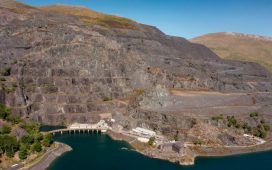Unlock the Editor’s Digest for free
Roula Khalaf, Editor of the FT, selects her favourite stories in this weekly newsletter.
A blueprint aiming to secure the future of Grangemouth, Scotland’s only oil refinery, which is due to close next year, is set to turn the facility into a biofuels manufacturing hub for processing trees, crops and human waste.
Consultants are scrambling to come up with a plan for the facility to boost the economy, prioritising domestic feedstocks and recycling technologies to minimise its climate footprint, said three people briefed on the study exploring development of the Falkirk site.
The UK and Scottish governments are under pressure to secure Grangemouth’s industrial future to ward off the loss of hundreds of jobs when the refinery closes next year while assisting the transition to a post-oil economy.
A state-funded task force named Project Willow was set up after Petroineos, a joint-venture between PetroChina and Ineos, which owns the Grangemouth refinery, decided to close the facility.
Westminster and Scottish politicians have expressed disappointment at Petroineos’s decision but have not yet pledged new money to transform the site.
The project, scheduled for completion at the end of January, aims to deliver a business plan for low-carbon industrial processes, including green hydrogen, that would hope to replace more than the 400 jobs set to be lost next year over a longer period.
“There is a strong project set revolving around three big buckets — recycling, biofuels and hydrogen,” said one person briefed on the findings.

Work on Project Willow, involving consultancy EY, is about three-quarters complete and its current recommendations are subject to change.
There is no guarantee that Petroineos, a participant in the project along with national and regional governments, local industries and education providers, would take forward proposals for a green transition.
The technologies under consideration are proven to be scalable, the people said, but the government would need to change regulatory policies and make cornerstone investments to lure private capital into these emerging sectors.
“The theme is around circularity, making sure feedstock volumes are as local as possible and that we can make the economies work, so the facility can stand on its own two feet,” said the person.
Green industrial processes may produce fewer jobs than the existing refinery, the people said, but there would be more indirect posts created through the feedstock supply chain, including in forestry, agriculture, recycling, carbon capture and sewage treatment.
Recycling plastics and chemicals would form a major part of the facility’s potential output.
Processing sewage sludge into biomethane could potentially be used as a complementary fuel for the UK’s natural gas grid and to produce bio-oils.
Hydrogen, a pillar of Scotland’s national green industrial strategy, would also play a significant part in the near-term development of Grangemouth, the people said, using surplus offshore wind capacity to create hydrogen as a feedstock for high-value chemicals and fuels.
Project Willow has identified forestry as a viable domestic feedstock for biofuels. Planting more trees would capture carbon dioxide that could then be processed into high-margin products, such as sustainable aviation fuel or green diesel.
“One-hundred fifty years ago, Scotland had a strong timber industry, but it declined over time,” said the person. “Could we reignite that with help of the government?”

The expansion of forestry is a contentious issue in some rural communities, who say fast-growing conifers mar the landscape and encroach on agricultural land.
“If there is pushback saying this is inefficient use of land, then we would ask what it’s being used for today and what are the plans for tomorrow,” said the person. “If some land is not being used, why not plant trees?”
Non-food crops, such as camelina, could be included within the feedstock mix along with waste fats, oil and grease.
Rotating such crops into harvest cycles would deliver a “double whammy” of benefit for farmers through extra income and soil enhanced by potassium and nitrates. However, the government would need to incentivise farmers to test new plants.
Unite, a union, has formed a plan for investment to extend the life of the refinery, while low-carbon manufacturing options are drawn up.
New manufacturing facilities could be operational within a decade, scaling up through the 2030s and reaching full potential beyond 2040, the study indicated.
Climate Capital

Where climate change meets business, markets and politics. Explore the FT’s coverage here.
Are you curious about the FT’s environmental sustainability commitments? Find out more about our science-based targets here










